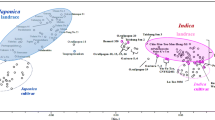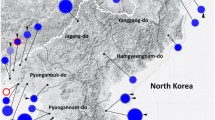Abstract
Indica–japonica variation represents the most significant genetic differentiation in Asian cultivated rice (Oryza sativa L. subsp. indica Kato or subsp. japonica Kato). Understanding the differentiation and distribution patterns of cultivated rice along altitude gradients will facilitate strategic utilization and conservation of rice germplasm from mountainous regions. In this study, we analyzed 203 varieties and 14 wild accessions of rice collected from localities across an altitude gradient between 450 and 2,350 m above sea level in Yunnan, China, applying the “InDel molecular index” developed recently. Results from PCA of the InDel data demonstrated significant genetic differentiation of rice varieties from Yunnan into indica and japonica types. A few cultivars and nearly all wild rice accessions showed only moderate or no differentiation. Further analyses demonstrated a clear distribution pattern of the rice varieties in the mountainous region: indica varieties were grown across the entire altitude gradient in the sampling areas, but most japonica varieties were found above 1,400 m. These results clearly indicated that indica rice could be cultivated in areas at much higher altitudes than those categorized by the traditional methods. The knowledge opens a new dimension for introducing indica rice varieties to mountainous regions at higher altitudes and for selecting rice germplasm in these regions. In addition, the pattern of significant indica–japonica differentiation in rice varieties from Yunnan suggested the exotic origin of cultivated rice, which did not support the hypothesis that Yunnan is a part of the center of origin of rice, although it is certainly one of the centers of genetic diversity for rice.



Similar content being viewed by others
References
Bellon MR, Brar DS, Lu BR, Pham JL, Dowling NGGSM, Fischer KS (1998) Rice genetic resource. In: Dowling NG, Greenfield SM, Fischer KS (eds) Sustainability of rice in the global food system. Pacific Basin Study Center and IRRI, Manila, pp 251–283
Blair MW, Panaud O, McCouch SR (1999) Inter-simple sequence repeat (ISSR) amplification for analysis of microsatellite motif frequency and fingerprinting in rice (Oryza sativa L.). Theor Appl Genet 98:780–782
Cai XX, Liu J, Qiu YQ, Zhao W, Song ZP, Lu BR (2007) Differentiation of indica–japonica rice revealed by insertion/deletion (InDel) fragments obtained from the comparative genomic study of DNA sequences between 93-11 (Indica) and Nipponbare (Japonica). Front Biol China 2:291–296
Chang TT (1976) The origin, evolution, cultivation, dissemination and diversification of Asian and Africa rices. Euphytica 25:435–441
Chang TT (1984) Conservation of rice genetic resources: luxury or necessity? Science 224:251–256
Chang TT (1985) Crop history and genetic conservation: rice—a case study. Iowa State J Res 50:425–455
Chang TT, Oka HI (1976) Genetic variousness in the climatic adaption of rice cultivars. In: Proceedings of the symposium on climate and rice. International Rice Research Institute, Los Baňos, Philippines, pp 87–111
Cheng KS, Wang XK, Lu YX (1984) The synthetical research and utilization of Yunnan rice resource: the reorganization of the Asian cultivated rice classification. Acta Agronomica Sinica (in Chinese)10:271–279
Fuller DQ, Harvey E, Qin L (2007) Presumed domestication? Evidence for wild rice cultivation and domestication in the fifth millennium BC of lower Yangtze region. Antiquity 81:316–331
Fuller DQ, Qin L, Zheng YF, Zhao ZJ, Chen XG, Hosoya LA, Sun GP (2009) The domestication process and domestication rate in rice: spikelet bases from the lower Yangtze. Science 323:1607–1610
Glaszmann JC (1987) Isozymes and classification of Asian rice varieties. Theor Appl Genet 74:21–30
Guan YB (2005) Historical development of Yunnan rice cultivation. In: Guan YB (ed) Origin history of rice cultivation in Yunnan. Beijing National Publishing Company, Beijing, China, pp 82–105 (in Chinese)
Jin L, Su B (2000) Natives or immigrants: modern human origin in East Asia. Nat Rev Genet 1:126–133
Kato S, Kosaka H, Hara S (1928) On the affinity of rice varieties as shown by fertility of hybrid plants. Bull Fac Agric Kyushu Univ 3:132–147
Li KS (1981) Contribution of Yunnan in origin research of Asian cultivated rice. Soc Sci Yunnan 1:69–72 (in Chinese)
Li KS (2004) Archeology achievement on Yunnan human origin in prehistory. Soc Sci Yunnan 2:108–136 (in Chinese)
Li ZC, Zhang HL, Zeng YW, Yang ZY, Shen SQ, Sun CQ, Wang XK (2000) Study on sampling schemes of core collection of local varieties of rice in Yunnan. China Scientica Agricultura Sinica 5:1–7 (in Chinese)
Li ZC, Zhang HL, Zeng YW, Shen SQ, Sun CQ, Wang XK (2001) Studies on phenotypic diversity of rice germplasm in Yunnan, China. Acta Agronomica Sinica 6:832–837 (in Chinese)
Liu ZM (1975) Origin and development of Chinese cultivated rice. J Genet Genomics 1:23–29 (in Chinese)
Londo JP, Chiang YC, Hung KH, Cheng TY, Schaal B (2006) Phylogeography of Asian wild rice reveals multiple independent domestications of cultivated rice, Oryza sativa. Proc Natl Acad Sci USA 103:9578–9583
Lu BR, Zhu YY, Wang YY (2002a) The current status and perspectives of on-farm conservation of crop genetic diversity. Biodiv Sci 10:409–415 (in Chinese)
Lu BR, Zheng KL, Qian HR, Zhuang JY (2002b) Genetic differentiation of wild relatives of rice as referred by the RFLP analysis. Theor Appl Genet 106:101–106
Lu BR, Cai XX, Jin X (2009) Effecient indica and japonica rice identification based on InDel molecular method: its implication in rice breeding and evolutionary research. Prog Nat Sci 19:1241–1252
Mao YQ (2000) On the Hani southern migration and rice—farming culture. J Yunnan Univ Natl 5:56–57 (in Chinese)
Morishima H, Gadrinab LU (1987) Are the Asian common wild-rices differentiated into the Indica and Japonica types? In: Hsieh SC (ed) Crop exploration and utilization of genetic resources. Taichung Dist Agric Impr Stat, Taiwan, pp 11–20
Morishima H, Oka HI (1981) Phylogenetic differentiation of cultivated rice. XXII. Numerable evaluation of the indica–japonica differentiation. Jpn J Breed 31:402–413
Morishima H, Shimamoto Y, Sato T, Yamagishi H, Sato YI (1991) Observations of wild and cultivated rices in Bhutan, Bangladesh and Thailand. Report of the National Institute of Genetics, Japan
Oka HI (1988) Origin of cultivated rice. Development in crop species. Japan Scientific Societies Press, Tokyo
Oka HI, Chang WT (1963) A note on rice varieties of Japonica type found in northern Thailand. Bot Bull Acad Sci 4:163–168
Sano R, Morishima H (1992) Indica-japonica differentiation of rice cultivars viewed from variations in key characters and isozymes, with special reference to landraces from the Himalayan hilly areas. Theor Appl Genet 84:266–274
Sano R, Konishi T, Morishima H (1985) An altitudinal cline of isozyme variation found in landrace populations of Nepalese rice. Rice Genet Newsl 2:51–52
Shen YJ, Jiang H, Jin JP, Zhang ZB, Xi B, He YY, Wang G, Wang C, Qian L, Li X, Yu QB, Liu HJ, Chen DH, Gao JH, Huang H, Shi TL, Yang ZN (2004) Development of genome-wide DNA polymorphism database for map-based cloning of rice genes. Plant Physiol 135:1198–1205
Sun CQ, Wang XK, Yoshimura A, Doi K, Iwata N (1997) RFLP analysis of nuclear DNA in common wild rice and cultivated rice. Scientia Agricultura Sinica 30:37–44 (in Chinese)
Sun CQ, Wang XK, Yoshimura A (2002) Genetic differentiation for nuclear, mitochondrial and chloroplast genomes in common wild rice (Oryza rufipogon Griff.) and cultivated rice (Oryza sativa L.). Theor Appl Genet 104:1335–1345
Tu M, Lu BR, Zhu YY (2007) Abundant within-varietal genetic diversity in rice germplasm from Yunnan Province of China revealed by SSR fingerprints. Biochem Genet 45:789–801
Vaughan DA, Balazs E, Heslop-Harrison JS (2007) From crop domestication to super-domestication. Ann Bot 100:893–901
Vaughan DA, Lu BR, Tomooka N (2008) The evolving story of rice evolution. Plant Sci Rev 174:394–408
Wang YH, Li JY (2006) Genes controlling plant architecture. Curr Opin Biotechnol 17:123–129
Wang ZY, Second G, Tanksley SD (1992) Polymorphism and phylogenetic relationships among species in the genus Oryza as determined by analysis of nuclear RFLPs. Theor Appl Genet 83:565–581
Wang XK, Li RH, Sun CQ, Li ZC, Cai HW, Sun XL (1997) Identification and classification of subspecies of Asian cultivated rice and hybrids among subspecies. Chin Sci Bull 24:2596–2602
Wang XK, Sun CQ, Cai HW, Zhang JZ (1998) Origin and evolution of China rice cultivation. Chin Sci Bull 22:2354–2363
Xia HB, Lu BR (2009) Software for transforming Co-dominant genotype scores into binary data matrix: its application to genetic diversity research. J Plant Genet Resour 10:97–102 (in Chinese)
Xu XH, Wang HX, Wang GC (1974) Report of indica–japonica vertical distribution in Simao of Yunnan province. Acta Botanica Sinica 16:208–222 (in Chinese)
You XL (1975) Origin, differentiation and dissemination of Chinese cultivated rice base on the ancient rice from Hemudu site. Acta Agronomica Sinica 5:1–10 (in Chinese)
Zeng YW, Li ZC, Yang ZY, Wang XK, Shen SQ, Zhang HL, Chen YM (2000) Law and center of diversity of main characters of indigenous rice (Oryza sativa L.) in Yunnan. Journal of Huazhong Agricultural 19:511–517 (in Chinese)
Zeng YW, Li ZC, Yang ZY, Shen SQ, Zhang HL, Wang XK (2001a) Geographical distribution and cline classification of indica/japonica subspecies of Yunnan local rice resources. Acta Agronomica Sinica 1:16–20 (in Chinese)
Zeng YW, Li ZC, Shen SQ, Wang XK, Yang ZY, Zhang HL, Chen YM (2001b) Diversity and good germplasm of indigenous rice varieties in Yunnan Province. Chin J Rice Sci 15:169–174 (in Chinese)
Zhang QF, Saghai-Maroof MA, Lu TY, Shen BZ (1992) Genetic diversity and differentiation of indica and japonica rice detected by RFLP analysis. Theor Appl Genet 83:495–499
Zhang HL, Sun JL, Wang MX, Liao DQ, Zeng YW, Shen SQ, Yu P, Mu P, Wang XK, Li ZC (2007) Genetic structure and phylogeography of rice landraces in Yunnan, China, revealed by SSR. Genome 50:72–83
Zhao SQ (1991) Historical development and geographic distribution of agriculture (farming) in China. Geogr Res 1:1–11 (in Chinese)
Zhao W, Xia HB, Zhang SJ, Cai XX, Lu BR (2008) Differentiation of Oryza species revealed by the indica–japonica specified insertion/deletion (InDel) molecular markers. J Fudan Univ 47:281–287 (in Chinese)
Zhu YY, Chen HR, Fan JH, Wang YY, Li Y, Chen JB, Fan JX, Yang SS, Hu LP, Leung H, Mew TW, Teng PS, Wang ZH, Mundt CC (2000) Genetic diversity and disease control in rice. Nature 406:718–722
Zhu YY, Wang YY, Chen HR, Lu BR (2003) Conserving traditional rice varieties through management for crop diversity. Bioscience 53:158–162
Zhu MY, Wang YY, Zhu YY, Lu BR (2004) Estimating genetic diversity of rice landraces from Yunnan by SSR assay and its implication for conservation. Acta Bot Sin 46:1458–1467
Zong Y, Chen Z, Innes JB, Chen C, Wang Z, Wang H (2007) Fire and flood management of coastal swamp enabled first rice paddy cultivation in east China. Nature 449:459–462
Acknowledgments
This study was supported by the 973 Program (Grant No. 2006CB100205) from the Chinese Ministry of Science and Technology, Shanghai Commission of Science and Technology (Grant No. 08JC1401700), and Italian Ministry of Environment and Environmental Protection, within the research project “Application of biotechnology to the protection of the environment in collaboration with China (years 2005–2007)”.
Author information
Authors and Affiliations
Corresponding author
Additional information
Zhiyuan Xiong and Shujie Zhang contributed equally to this work.
Rights and permissions
About this article
Cite this article
Xiong, Z., Zhang, S., Wang, Y. et al. Differentiation and distribution of indica and japonica rice varieties along the altitude gradients in Yunnan Province of China as revealed by InDel molecular markers. Genet Resour Crop Evol 57, 891–902 (2010). https://doi.org/10.1007/s10722-009-9528-x
Received:
Accepted:
Published:
Issue Date:
DOI: https://doi.org/10.1007/s10722-009-9528-x




